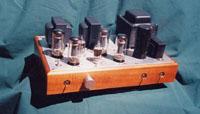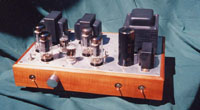The story of Poindexter
and the little junkbox amp that could.
I've also included a page showing the speakers I use with it.

 Here's a look at the amp. Image is a thumb.
Here's a look at the amp. Image is a thumb.
 Here's another view. Also a thumb.
Here's another view. Also a thumb.

"A lot of influences came together to make this amp."
The DIY audio equivalent of, "Once upon a time," right? Like many kitchen table hi-fi designers of that time (the early '90's), I'd come through Dyna 70 mods to the study of the Williamson amplifier, and then branched off from there. Single-ended output circuits were a glow on the horizon; the big time hi-end guys were paralleling KT88's to get the power needed to drive the byzantine crossovers of 82dB Celestions and Kefs. My own experimentation with passive control for the ST-70 had led me to the conclusion that pre-amps for line level sources are a drag. Plugging my CD player directly into the Dyna gave a wonderfully clear and dynamic, and unacceptably loud, presentation through the amp. Why not just put a selector switch and volume pot into the amp, sidestepping the two-interconnects impedence problem of passive preamps, and eliminate the line preamp entirely? This, as a mod to the ST-70, worked so well that it started me on the simpler-is-better design rationale that I'm still exploring.
Its first product was a direct input amp (that you can see here) using the most common tubes I could think of, that was a sort of ultimate Williamson for line input; the most elegant and optimized power amp of this kind. This was a very successful design, considering how much I actually knew about tube circuit design at the time; I even sold a couple of them. I still think that if you don't have a lot of money to invest, and your speakers are pretty low in sensitivity (or for some other reason you need 18 watts of output), you can't go wrong with this amp.
I ran just about every sort of test and mod on this amp you can think of, and among them was a test of just how much power I was drawing from the amp when listening. This was sort of a worst case; 88dB minimonitors in a pretty dead, pretty lossy room of about 4000 cubic feet volume. Using pink noise (actually FM interstation noise; musical signal has a peak-mean ratio that makes it practically impossible to take measurements with) at a good loud normal listening level, I measured voltage at the speaker terminals that corresponded to about 3 watts out. With my regular 90dB speaks (the ones shown on the site here), draw was about 2 watts. I had way more power than I needed. About this time, I noticed an article in Sound Practices about an amp using 6BX7 low power triodes in the output, for which the author, Ed Warden, claimed 5 watts out. The topology of this circuit was practically identical to that of my amp without the front end amplifier. Just the singly-driven differential amp driver, and the outputs. Ooh; it looks so clean; simpler is better, right?
Living way out in the weeds, I'd been pulling the transformers and some other parts for my designs from old orphan tube gear, mostly late model low-line stuff from Fisher, Scott, and Harmon Kardon. These amps used easy-drive pentodes like the 7355, 7591, EL84, that all used high-ish impedence output transformers; and I even had a dead Harmon receiver that used 6V6's under my bed; the iron suitable for EL84's, 6BX7's, or 6BL7's as well. A friend of mine had the local hi-fi and pro fixit shop (from whose 'dead' shelves I had acquired a good deal of this orphan gear), and one day when I stopped in, he was playing a radio through a guitar amp, to test the repair. This was hardly hi-fi, but it was such a clear, musical sound that I commented on it. "Push-pull 6V6's." he said, "They're the best tone in pro audio; no way you can make 'em sound bad. Sound even better in triode. No power, though; six, eight watts, max. Hey, where ya goin'? I say somethin' wrong?"
It did become apparent, when I did the arithmetic, that drive to the outputs was going to be a bit of a problem. The 6V6, when operated in fixed bias (which I like, and which really helps the Zout and power out), has a grid circuit max resistance of 100 Kohm. This resistance is in parallel to the load resistor of the driver tube in forming its net load resistance; so the net load is never going to be below 80Kohm or so. The big-mu front end tubes like the 12AX7 and 6SL7 have plate resistance in the 50K-80K range, and the thumbnail rule is that you want to load a triode at 4 to 5 times its plate resistance for lowest distortion and best voltage drive; all the voltage would get divided away, and distortion would go into low earth orbit somewhere. I saw an interesting tube on Steve's (Angela Instruments) site; the 5965, a computer tube. 7-8K plate resistance, 6-7 mA/v gm, so a mu of 48 or so. It didn't hurt that he was sale pricing this (then) unknown device at fifteen for ten bucks; very much in keeping with the proposed amp's alley-cat ontology.
Still, drive looked marginal. A 6V6 at normal operating point will have a bias voltage of about -20 to -22 volts, so you need about 15Vac for full modulation; and you'd like to fully modulate a line level amp with 1Vac in, for 50% headroom. Loading the 5965's optimally, I'd see a max gain of around 17 or 18, which is okay so far; but I was a Williamson kid, remember? I was used to using 6-8dB of negative feedback to keep the distortion and output impedence down, and 1-2dB here would use up all my gain headroom; hardly worth even putting the loop in. By this time curiosity was prodding me pretty heavily, however; so I proceeded with prototyping.
It was right at this time that I heard my first single-ended directly heated triode amp, my friend Ike's Cary (AES) that used the Svetlana SV811-3 for output. I've never heard much about this amp, then or since, and it's not without some small problems; but from 100Hz up it's maybe the best amplifier I ever heard to this day. It remains my reference for transparency, dynamics, and naturalness, and its utter clarity put to rest any misgivings I had about zero-feedback circuits. I had already built the feedback loop into the prototype, terminating one resistor short of the 'off' driver grid; I took it out, along with all the grid-stop resistors except the 100 ohm damper in the screen-to-plate triodizing connection of the 6V6's, confident (okay, hoping) that this clean, low impedence circuit would have ultra-fi bandwidth.
This proved to be one of those very fortunate guesses that we make, once in a while; as a result of all the unfortunate ones in between. The amp was quiet as a mouse (AC filaments and all) right from first fire-up, and operated and sounded pretty much as it does now; only requiring some resistor adjustments for wayward transformer voltages and other standard prototype blahs. It's maybe just a bit more 'amplifier' sounding than the SV811, but as good or better than 2A3 and 300B amps I've since heard, and much more solid and deeper in the bass than the SV811; rivalling the 2A3. With a 7.2K load on the outputs, it'll deliver a little over 6 watts at the onset of steady-state clipping; about the same as a SE 300B optimally loaded. This does make me suspect Ed's 5 watt rating for his 6BX7's of being perhaps a little, ah, hopeful. I bet it sounded like 5 watts, though; On 90dB speaks in the 4000 ft.³ room, I never ran out of power with this amp; in fact it would play louder than it will in the 1200 cu. ft. room I have it in now, which clogs up the sound with early reflections long before the amp starts working hard. Another useful data point on the power-versus-music curve, which was one of the main questions of this experiment in the first place.
I've included a fairly extensive set of instructions for implementing this amp, in case you're a DIY pervo; and I do make them for sale, for prices which I try to keep reasonable, and depending on the amount of prettiness you'd like. I assure you that the sonics of this piece of gear are not out of place in a pretty deluxe package in either case; and in either case I welcome your comments or questions. Feel free to post me at poinxie@yahoo.com. This amp has been built as is, and in various offshoot forms; I'm interested to see what people are doing with it.
As always, it's considered bad manners to knock off somebody else's design for profit. You want to make the thing commercially, we should make arrangements. For yourself or for your buddy, free of, um, fiscal considerations, I urge you to go for it.
Poinz